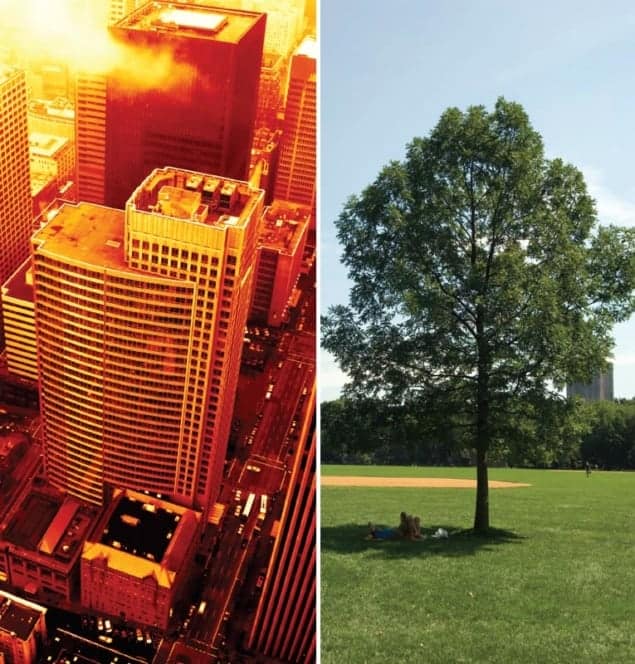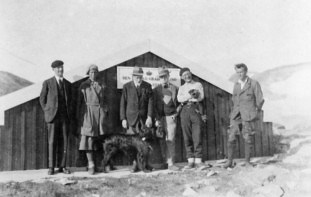Summer in the city can be stifling, with heat rising from tarmac and air-conditioners pumping out stuffy air. But appropriate surfaces and vegetation can make the urban environment a cooler, cheaper and greener place to live, says Roland Ennos

The picture-perfect summer for many involves dipping toes into the water’s edge on a sandy beach, strolling through a park licking an ice cream or cracking open a bottle of cold beer as gorgeous smells waft from a barbecue nearby. But if you live in a city – and over half the world’s population now do – your enjoyment of the summer is probably reduced by your surroundings. Cities are hot, noisy places with poor air quality that are prone to flash flooding during storms. In cities we are guilty of using huge amounts of energy for cooling in summer, heating in winter and transport the whole year round. Making cities more pleasant and sustainable places in which to live is therefore one of the key goals of environmental research, and it is one that physicists are ideally suited to contribute to, since most urban environmental problems are best understood in physical terms.
Physicists across the world, particularly those working in environmental physics and meteorology, are now collaborating with scientists from other disciplines to study the environmental performance of cities and establish how “green” these urban environments are. One particularly important environmental characteristic of cities is the “urban heat island”, whereby urban areas are hotter than their surrounding countryside. This is a real problem, which will be made even worse by climate change. It has therefore become a prime focus of research.
The urban heat island
Cities are typically about 4 °C hotter than the surrounding countryside and the larger they are, the bigger the difference. To understand why, we must consider the energy balance of the two areas (figure 1). Although heating, air-conditioning and transport all produce energy in cities, this is a surprisingly small component of their heat balance – only about 50 W m–2. Except for in winter, this is dwarfed by the energy we receive from the Sun, which even in the UK peaks at more than 800 W m–2. The difference between temperatures in a city and the surrounding countryside is therefore mostly due to what happens to the Sun’s energy in the two environments.
In rural areas, vegetation reflects about a quarter of the incoming short-wave radiation (visible light or shorter wavelengths). Of the three-quarters that is absorbed, much of the energy is used to evaporate water from leaves – a process known as “evapotranspiration”. This cools the vegetation, which therefore radiates little long-wave radiation (infrared), and even less energy remains to heat the air by convection and to heat the soil by conduction.
In cities, where vegetation has largely been replaced by buildings and roads, the energy balance is dramatically altered. Dark, artificial materials reflect less – and absorb more – radiation than vegetation. This lower “albedo” means that only about 10% of the Sun’s radiation is reflected; this figure is even lower in high-rise cities where light is reflected down into urban “canyons”. Almost all of this energy goes into heating the dry roads and roofs, where it is either stored in bricks and mortar or heats the air above, thus raising daytime surface and air temperatures well above those of the surrounding countryside.

At night the difference in temperature between the countryside and the urban heat island can become even more pronounced. Cities cool down more slowly because there is more heat stored in its buildings, which continues to dissipate into the night; there is more pollution to trap long-wave radiation; and within urban canyons less of the cool sky is visible, so less radiation can escape.
All this causes major problems for city-dwellers. The rise in urban air temperature above that of the surrounding countryside, which can reach 7 °C in a metropolis like London, makes cities less comfortable places to live in during the summer months. Soaring temperatures increase ill health and can even kill people during heatwaves: it is thought that more than 35,000 people died in Europe as a result of the 2003 heatwave, most of them in towns and cities. The urban heat island also makes cities less sustainable, since it increases the amount of energy used for air-conditioning – energy that is pumped into the open air and just makes the situation worse. Fortunately, physics shows that two very different methods could be used to alleviate the urban heat island: using “cool surfaces”; and using vegetation, or “green infrastructure”.
Cool surfaces
Increasing the albedo of buildings and roads so that they reflect more sunlight is an approach that has been used for centuries in the Mediterranean – think of whitewashed villages in Greece, southern Italy and Spain. At the Lawrence Berkeley National Laboratory in California, the effectiveness of this approach has been investigated by the Urban Heat Island Research Group, led by physicist Hashem Akbari. The cooling effect of a roof’s surface depends on its reflective and emissive properties – its ability to reflect short wavelengths such as visible light and near-infrared radiation, and to emit thermal radiation in the far infrared. While standard white-painted surfaces are good at keeping cool, it is also possible to make medium-to-dark-coloured cool surfaces, which can look more traditional on roofs. These are created by combining a reflective basecoat, such as white titanium dioxide, with a darker pigment that has moderate visible reflectance, such as iron-oxide red or perylene black. As long ago as 1999, Akbari’s group showed that these “cool surfaces” can reduce the peak temperatures of roofs and pavements in California from 50 °C down to about 30 °C.
The same group has also studied the implications of this cooling for individual buildings. First, the researchers compared the thermal performance of conventional buildings with identical ones that had roofs clad in cool surfaces. These tests showed that in summer, cool surfaces typically reduce air-conditioning costs by 20–30%. However, these experiments – by necessity – ignored the cumulative cooling effect that could result from large-scale use of cool materials throughout an entire city.
To study the effect of cool materials on the urban heat island, Akbari’s group had to use more indirect methods, as clearly it is not practicable to perform a controlled experimental study comparing two cities that are identical in all respects bar their surface cover. What the researchers did was simulate air temperatures in the Los Angeles area using complex and computer-intensive regional climate models. The calculations suggested that the urban heat island could be reduced by 2 °C if all buildings and roads were covered by surfaces with an albedo 30% higher than is there now. This would reduce summer air-conditioning costs by a further 2–3%.
Tree-shaded buildings
A potentially even more effective method of preventing the urban heat island than using cool surfaces is to increase both the albedo and evaporative cooling of cities using vegetation and water. Once again, this approach has long been popular in Mediterranean towns, which have cool squares and boulevards shaded by trees and chilled by fountains.
Researchers in the US, such as Akbari’s group and the Forest Service of the United States Department of Agriculture (USDA) led by David Nowak, have mostly concentrated on how tree shade can reduce the air-conditioning costs of buildings. Experiments and computer modelling have shown that several large trees strategically planted on the south and west sides of buildings can cut these costs by about 30%. However, the cooling effect of the existing trees in the city they studied – Chicago – is only about 4–5%, due to limited tree cover in the city, particularly in heavily built-up areas.
Researchers in Germany and Canada, meanwhile, have concentrated on the effects of a different approach: incorporating vegetation onto the roofs of buildings to create “green roofs”. Studies in 2008 by Brad Bass and his group from the Centre for Environment at the University of Toronto showed that by using green roofs, air-conditioning costs can be reduced by up to 70% in single-storey buildings because the vegetation cools the roof by evapotranspiration and because the soil insulates the rooms below from the heat. However, these savings fall to about 30% and 20% for two- and three- storey buildings, respectively.
Tree-lined streets
It has proved harder to determine how effective vegetation is at cooling a city itself, because of its complexity; vegetation increases both albedo and evaporative cooling, and has lots of layers of leaves, which are hard to represent in regional climate models. One attempt has been made by Limor Shashua-Bar and Milo Hoffman of the Technion Israel Institute of Technology, who found that heavily wooded streets in Tel Aviv could have air temperatures up to 4 °C cooler than their surroundings. However, the researchers had to represent the effect of the trees not by a detailed model but by simply reducing the incoming radiation by 40%. Before we can accurately model the effects of vegetation on the urban heat island, we clearly need to know more.
One approach to work out what is happening, taken by a group from the University of Basel, Switzerland, and led by botanist Sebastian Leuzinger and meteorologist Roland Vogt, is to use a high-resolution thermal camera mounted on a helicopter. The researchers measured the surface temperature of parts of Basel on a hot summer’s day when the air temperature was 25 °C. They found that streets reached temperatures of 37 °C and roofs 45 °C, whereas the temperatures of trees were on average only 25 °C and of water bodies just 18 °C. Potentially, these figures could be put into a regional climate model to give an indication of the effects of the trees on air temperatures. However, this would ignore the depth of the tree canopy; the lower layers of leaves, being shaded by the top ones, will be cooler than those above. Trees will therefore provide more cooling than would be predicted from thermal-camera measurements.
To solve this problem, my group at the University of Manchester, which includes physicists, biologists and planners, used a simple energy-balance model to calculate the surface temperatures of typical vegetation, buildings and roads (figure 1). Originally developed by Chih Pin Tso, then at the University of Malaya, Kuala Lumpur, in the 1990s, the model suggested that vegetation is more effective than the thermal measurements of Basel would suggest. On hot days, the predicted maximum temperature of woodland was 18–25 °C cooler than that of buildings and roads.
Our group used the area of Greater Manchester as a case study, which encompasses the city of Manchester and its extended urban sprawl. First, we categorized the area’s pattern of vegetation using aerial photography (figure 2) and found that, surprisingly for a built-up industrial area, 59% of Greater Manchester is covered by evapotranspiring vegetation. Of course the vegetation cover, and hence surface temperatures predicted by the model, was not uniform across the area. Built-up areas such as city centres had vegetation cover of less than 30% and were up to 13 °C hotter than green spaces. We also manipulated the green space in the model to perform “experiments” that would normally be impracticable. For instance, we showed that adding 10% tree cover to city centres would reduce maximum surface temperatures by about 4 °C. The results of our study, however, really need to be put into a regional climate model that can calculate air temperatures.

One other thing scientists need to discover is how good trees and grass are at cooling relative to one another. The best way to do this would be to look at the energy balance of the surfaces more directly. Since plants cool themselves by evapotranspiration, and the heat of evaporation of water is constant at 2.43 kJ per gram, the cooling provided by a plant is proportional to its rate of water loss. One might expect trees to provide more cooling than grass, since their leaves are held higher up above the ground and so should lose water faster, like washing on a clothes line; on the other hand, trees have to pipe that water up to their leaves against gravity. Environmental physicists and botanists have developed techniques to measure water loss, which will allow us to test these ideas.
Water loss from grass is best measured by mounting turf onto a sensitive balance and monitoring weight loss throughout the day. Water loss from trees is measured using sap-flow meters: an electrically heated collar that applies bursts of heat is attached to the trunk of the tree to warm the sap within. Apparatus higher up the trunk monitors the temperature there, allowing the velocity and hence volume flow of water up the trunk to be calculated. Using these techniques, many studies by foresters and agronomists have found that forests and grasslands both give evaporative cooling of 100–200 W m–2. But there is little of this information available for urban grass and trees – and we have no idea how their cooling effectiveness might be limited by drought – so experimental work is urgently needed.
Respite from the Sun
A final climatic benefit of vegetation is to provide cool oases for recreation. Many studies have therefore compared air temperatures in parks with those in surrounding roads, only to find that, except on really windless days, the differences are rather small – usually less than 1 °C – because warm air is blown into the park from the surroundings. So why do we feel cooler in parks, and what effect does tree shading have?
To answer these questions we have to consider the heat balance of a person. At rest, a person’s body produces heat at a rate of about 60 W m–2 of our body surface. How hot we feel depends on how readily we can lose that heat to our surroundings. Surprisingly, except in very high winds, we lose very little heat by convection – only about 9 W m–2 – and about 15 W m–2 by evaporation from our breath. However, all bodies emit far-infrared radiation at a rate proportional to the fourth power of their temperature, but also absorb such radiation from their surroundings. Therefore, if our surroundings are cooler than 37 °C, we have a net radiative heat loss.
Outside in a shady park we feel comfortable because we are surrounded by cool leaves. On an open street, in contrast, we feel hotter for two reasons: first, we are receiving an additional input of up to 120 W m–2 of shortwave radiation from the Sun; second, the surrounding tarmac is also warmer, reducing radiative heat loss by about 6 W m–2 for every temperature increase of 1 °C. In such conditions we may have to sweat to get rid of the additional heat burden.
To investigate the relative importance of the Sun versus shade on the temperature of the surroundings, we carried out a simple experiment in summer 2009. This involved monitoring the radiant temperatures above grass and concrete plots, which were either in permanent sunlight or in the permanent shade of trees. We did this using a globe thermometer, which is basically a thermometer mounted inside a grey plastic sphere. Held at a height of 1.1 m, this mimics the thermal properties of an adult dressed in a suit. We found that being above grass or concrete had little effect on the radiant temperatures; these were far more influenced by shading, which reduced maximum radiant temperatures by up to 9 °C, from 35 °C to 26 °C. Since people tend to feel uncomfortable at radiant temperatures above 24 °C, it is clear that shading can have a large effect on people’s sense of wellbeing, thereby confirming the importance of trees in urban areas.
Influencing policy
All this research is building up a picture of how we can improve cities: trees have the most potential to improve street environments, whereas cool surfaces, green roofs and even “living walls” can improve the environmental performance of individual buildings. In addition, green infrastructure has other benefits, such as a reduction in flash flooding and particulate air pollution. Even so, there is clearly still a vast amount or research to do. We do not know which species of trees might be the best to cool cities and catch pollution particles, whether a single large tree is better than many small ones, or whether deciduous trees are better than evergreens. Nor do we know how the effectiveness of different types of vegetation will alter with climate change.
Nevertheless, we do now know enough to influence policy. The scientists of the USDA Forest Service, for instance, have collaborated with economists to estimate the monetary benefits of planting street trees, from reducing energy costs to reducing the health costs of air pollution. The economic model they have produced – the iTree model – shows that for every dollar put into planting and maintaining street trees, five dollars are saved. In New York, this knowledge, combined with the backing of Mayor Michael Bloomberg, has driven the planting of 20,000 extra street trees a year, while the Mayor of London, Boris Johnson, has also committed to planting 10,000 extra street trees during his term of office. As well as trees, the physical and economic case for green roofs means that they are being retrofitted to ever more buildings. It is good to be able to report that physicists are doing their bit to make our cities greener, pleasanter places in which to live.



